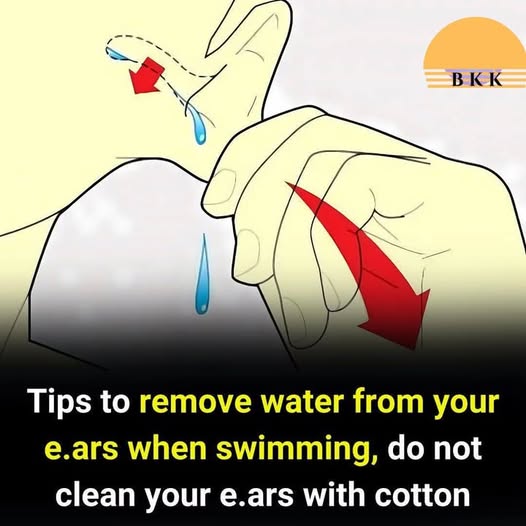If you’ve ever gone swimming and come out with that frustrating feeling of water stuck in your ears, you’re far from alone. Millions of people — especially during warmer seasons — experience this common issue. But health experts are now sounding the alarm about a dangerous habit many swimmers still rely on to fix the problem: using cotton swabs.
What might seem like a harmless way to dry your ears can actually lead to ear infections, hearing loss, or even permanent damage, according to leading ear, nose, and throat (ENT) specialists.
The Hidden Danger Behind a Common Habit
For generations, people have been told to clean their ears with cotton swabs — especially after a shower, swim, or if their ears feel blocked. The logic seems sound: swabs soak up moisture, so why not use them to remove trapped water?
But according to Dr. Megan Clark, an ENT at the National Hearing Institute, this habit does far more harm than good.
“The ear canal is a delicate structure. Cotton swabs not only fail to remove all the water but often push wax deeper into the ear, trapping moisture and creating the perfect conditions for infection,” Dr. Clark explained.
She adds that the repeated use of swabs can irritate the sensitive skin of the ear canal, increasing the likelihood of otitis externa, more commonly known as swimmer’s ear.
What Is Swimmer’s Ear?
Swimmer’s ear is a painful inflammation or infection of the outer ear canal, often caused by bacteria thriving in trapped water. Symptoms include:
-
Itching or redness inside the ear
-
Pain, especially when pulling on the earlobe
-
Muffled hearing
-
Discharge or a foul smell coming from the ear
-
Swelling around the ear canal
In severe cases, it can spread and lead to complications that require antibiotics or even emergency care.
Why Water Gets Trapped in Ears
The structure of the ear canal varies from person to person. Some people naturally have narrower or curved canals, making them more prone to water being trapped after swimming.
In other cases, excess earwax can block the canal, preventing water from draining properly. When water is trapped behind wax, it creates a humid environment where bacteria can multiply rapidly.
So What Should You Do Instead?
Here are safe, effective tips recommended by doctors for removing water from the ears — no swabs required:
✅ 1. Gravity Is Your Friend
Simply tilting your head sideways with the affected ear facing downward can often help. Gently tug on your earlobe to open up the canal and allow water to drain out naturally.
Jumping lightly or shaking your head while in this position can assist gravity in moving the water out.
✅ 2. Try the Vacuum Method
Cup your palm tightly over the ear and pump it back and forth to create gentle suction. This vacuum-like action can dislodge and pull water out.
✅ 3. Use a Blow Dryer — Cautiously
Doctors say a hair dryer can help evaporate moisture, but it must be used correctly:
-
Set the dryer to low heat and low speed
-
Hold it at least 12 inches away
-
Gently pull the earlobe while moving the dryer in a circular motion
Avoid aiming hot air directly into the canal and never use high heat.
✅ 4. Homemade Ear-Drying Drops
The CDC and ENT specialists suggest a safe drying solution made with equal parts rubbing alcohol and white vinegar.
This mix helps dry out water and kill bacteria that could cause infections.
-
Use a sterile dropper to put 3–4 drops into the ear
-
Tilt your head to let it drain after 30 seconds
-
Dry the outer ear with a clean towel
⚠️ Important: Do not use this method if you have a ruptured eardrum, ear surgery history, or tubes in your ears.
✅ 5. Avoid Tight Earplugs Unless Properly Fitted
Some swimmers use earplugs to prevent water from entering in the first place, but doctors warn that improper use of plugs can trap water rather than prevent it.
Consider investing in vented or custom-fit plugs designed for swimming if you’re frequently in the water.
❌ What You Should NOT Do:
-
Never insert cotton swabs (Q-tips), tissues, or any small object into the ear canal.
-
Avoid home remedies like oils, hydrogen peroxide, or garlic unless directed by a healthcare provider.
-
Don’t ignore symptoms like pain, itching, or muffled hearing — they could signal infection.
Why This Warning Matters
According to the Centers for Disease Control and Prevention (CDC), tens of thousands of people in the U.S. are treated each year for ear injuries or infections related to improper ear cleaning.
“It’s a silent epidemic,” said Dr. Clark. “Most people don’t realize how delicate their ears are until something goes wrong.”
The American Academy of Otolaryngology even recommends that nothing smaller than your elbow should go into your ears — emphasizing how easy it is to cause harm with common household items.
When to See a Doctor
If you experience any of the following after swimming or attempting to remove water from your ears, seek medical attention:
-
Ear pain that persists beyond 24 hours
-
Pus or bloody discharge
-
Severe itching or swelling
-
Hearing loss or ringing in the ears
-
Fever combined with ear symptoms
Prompt treatment can prevent long-term complications and hearing damage.
Final Thought: Prevention Is Key
While it may feel satisfying to “dry out” your ears with cotton swabs after swimming, the risks far outweigh the rewards. Instead, let gravity, warm air, and doctor-approved methods do the work.
And remember — your ears are self-cleaning organs. They don’t need swabs. They need care.
So next time you’re at the pool or the beach and come out with that muffled feeling in your ear, skip the cotton swab. Choose safety. Choose science.
Your ears will thank you.

